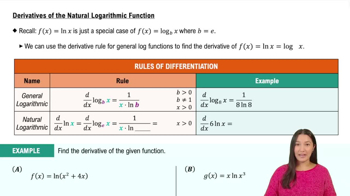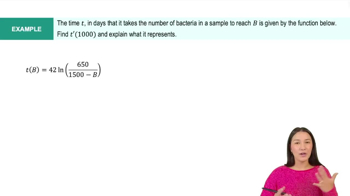Table of contents
- 0. Functions7h 52m
- Introduction to Functions16m
- Piecewise Functions10m
- Properties of Functions9m
- Common Functions1h 8m
- Transformations5m
- Combining Functions27m
- Exponent rules32m
- Exponential Functions28m
- Logarithmic Functions24m
- Properties of Logarithms34m
- Exponential & Logarithmic Equations35m
- Introduction to Trigonometric Functions38m
- Graphs of Trigonometric Functions44m
- Trigonometric Identities47m
- Inverse Trigonometric Functions48m
- 1. Limits and Continuity2h 2m
- 2. Intro to Derivatives1h 33m
- 3. Techniques of Differentiation3h 18m
- 4. Applications of Derivatives2h 38m
- 5. Graphical Applications of Derivatives6h 2m
- 6. Derivatives of Inverse, Exponential, & Logarithmic Functions2h 37m
- 7. Antiderivatives & Indefinite Integrals1h 26m
6. Derivatives of Inverse, Exponential, & Logarithmic Functions
Derivatives of Exponential & Logarithmic Functions
Problem 87d
Textbook Question
Determine whether the following statements are true and give an explanation or counterexample.
d/dx((√2)x) = x(√2)x - 1
 Verified step by step guidance
Verified step by step guidance1
Step 1: Recognize the function given is \( f(x) = (\sqrt{2})^x \). This is an exponential function where the base is \( \sqrt{2} \).
Step 2: Recall the derivative rule for exponential functions of the form \( a^x \), which is \( \frac{d}{dx}(a^x) = a^x \ln(a) \).
Step 3: Apply the derivative rule to \( f(x) = (\sqrt{2})^x \). The derivative is \( (\sqrt{2})^x \ln(\sqrt{2}) \).
Step 4: Compare the derived expression \( (\sqrt{2})^x \ln(\sqrt{2}) \) with the given expression \( x(\sqrt{2})^{x-1} \).
Step 5: Conclude that the given statement is false because \( (\sqrt{2})^x \ln(\sqrt{2}) \neq x(\sqrt{2})^{x-1} \). The correct derivative involves the natural logarithm of the base, not a multiplication by \( x \).
Recommended similar problem, with video answer:
 Verified Solution
Verified SolutionThis video solution was recommended by our tutors as helpful for the problem above
Video duration:
2mPlay a video:
Was this helpful?

 4:50m
4:50mWatch next
Master Derivatives of General Exponential Functions with a bite sized video explanation from Callie
Start learningRelated Videos
Related Practice














